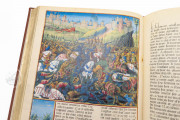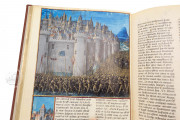The Passages de l'Outremer manuscript is a deluxe copy of a French-language text by Sébastien Mamerot describing the history of the French involvement in the Christian Holy Land from the legendary capture of Jerusalem by Charlemagne to the Crusades of the high Middle Ages. The manuscript was written and illuminated at Bourges around 1474-1475 for Louis de Laval, Lord of Châtillon. Jean Colombe, collaborating with assistants and other masters, supervised the creation of the volume's sixty-six large miniatures, which are remarkable for taking advantage of the entire page.
The bibliophile Louis de Laval commissioned Passages de l'Outremer ("Travels to the Holy Land") in early 1473, and Mamerot completed the text in April 1474. Work on the presentation copy began immediately and was probably completed the following year. In 1488 (or later), Latin and French versions of a letter written by Bayezid II (d. 1512), Sultan of the Turks, to Charles VIII (1470-1498), King of France, were added (fols. 3v-4r).
Battles and Pageantry
The manuscript's miniatures, reflecting Mamerot's text, focus on the events surrounding the European crusades in the Holy Land of the eleventh, twelfth, and thirteenth centuries. Signal events, such as Pope Urban II preaching the First Crusade at the Council of Clermont in 1095, are pictured (fol. 19r). The scene is set in a vast church interior adorned with statues and filled with French nobles and church dignitaries. The hair and garments of the figures are generously highlighted in gold.
Many miniatures depict vast armies on the march or field of battle (e.g., on fols. 21r, 34v, 37v, 44v, 47v, 59v, 71r, 140v, 143v, 153v, 197r, 222r, 235r, 248v, 251v, and 263v). The illuminators frequently give special attention to the details of large transport ships (e.g., on fol. 112r, 211r, 217r, 232v, and 269v) and war horses (e.g., on fols. 25v, 33r, 52r, 204v, and 260r). Grand architectural spaces and battlefield tents are portrayed in great detail (e.g., on fols. 188r and 202v). The dress and headgear of the Turks are clearly distinguished from that of the Europeans (fol. 267v).
Masterful Exploitation of Parchment Surface
The miniatures usually include more than one scene, with the paintings extending the entire height and width of the page, except for a panel of eight to twelve lines of text. This allowed for increased grandeur in portraying interior spaces and amplified the vastness of the landscape and the numbers of combatants in exterior scenes.
Artistic Team Led by Jean Colombe
Jean Colombe had already distinguished himself in the service of Queen Charlotte of Savoy (1441-1483), consort of Louis XI, by the time he began working on ambitious projects for Louis de Laval, including the lavish Hours of Louis de Laval. In the Passages de l'Outremer he worked with others, including the Master of the Yale Missal and Jean de Montluçon.
Elegant Cadelles
Mamerot's text, presented in eighty-eight chapters, emphasizes the role of French royalty and aristocracy in the Western presence in the Holy Land. Each chapter is headed by an extensive rubric describing the coming episode. The text is written in two columns in French Bâtarde, the preferred way of presenting long vernacular texts in the fifteenth century. Elaborate cadelles (flourishes of thick and thin pen strokes) are employed where space allowed (top lines of pages and at the start of rubrics).
Path to the French Royal Library
The manuscript's patron, Louis de Laval, is pictured in the opening miniature, dressed in a distinctive red garment with dagged sleeves, known as a houppelande (fol. 5r). He receives the text from the kneeling Sébastien Mamerot. The manuscript was the property of several members of the French aristocracy before coming into the library of Cardinal Jules Mazarin (1602-1661) and thence into the French royal library, the foundation collection of the Bibliothèque nationale (now Bibliothèque nationale de France).
We have 1 facsimile edition of the manuscript "Passages de l'Outremer": Passages d'Oultremer: La Gran Historia de las Cruzadas facsimile edition, published by Club Bibliófilo Versol, 2012
Request Info / Price






































